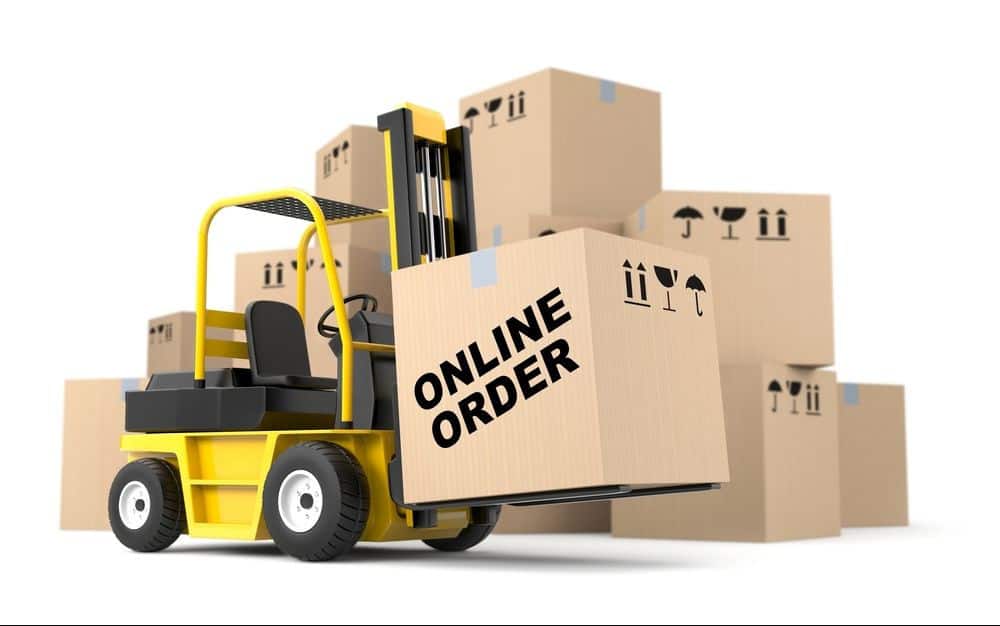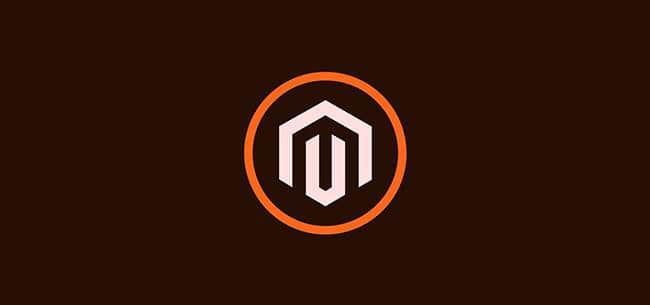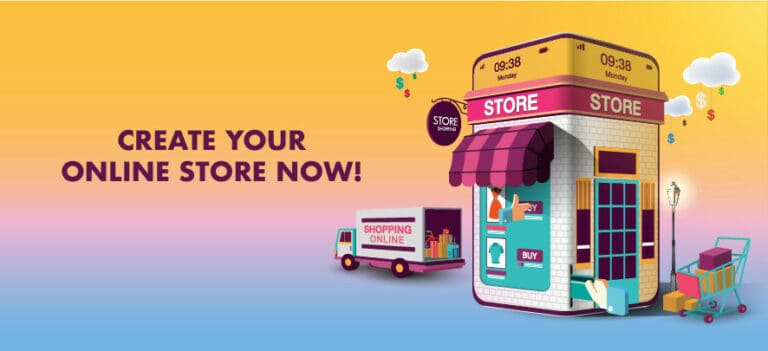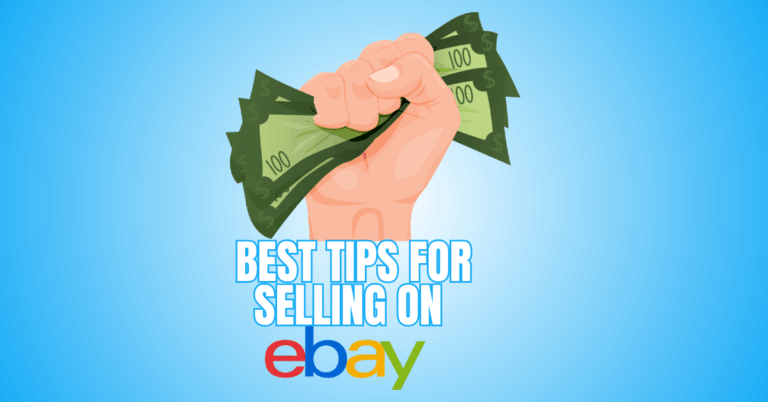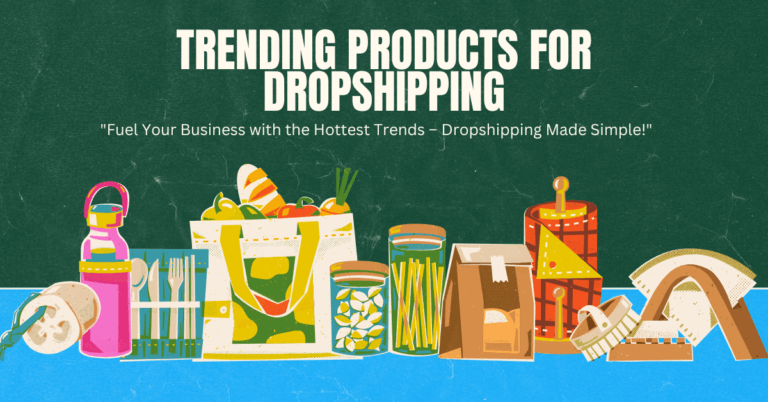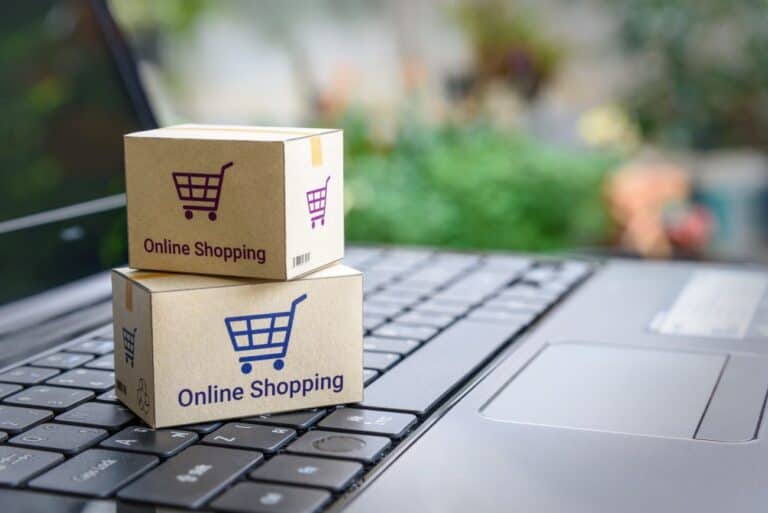WooCommerce Made Simple – An Easy Step-by-Step Tutorial
Introduction To WooCommerce Made Simple – An Easy Step-by-Step Tutorial
Here, we will be providing an easy-to-follow and step-by-step tutorial on WooCommerce that is great for people who are not experts in electronics. This economical, adjustable, and easy to manage software is one of the world’s most popular eCommerce platforms.
It is a bit scary for many beginners to set up WooCommerce themselves because they struggle to find out how to get started and the right way to set up WooCommerce.
What Is WooCommerce?
WooCommerce, the most popular eCommerce platform globally, is a free software for selling services and products online. Millions of large and small businesses (online stores) around the world are using WooCommerce.
WooCommerce is built as an extension of WordPress, the most popular website builder. It enables people to create an eCommerce website from the beginning or add shopping cart functionality to an existing website. Although WooCommerce is free, domain name and web hosting service to set up a website cost money. We will address pricing in the next paragraph.
What Do You Need To Make A WooCommerce Store?
To make a WooCommerce website from the beginning, you need three essential items:
- A WordPress hosting account. Your hosting company will store all of the files from your website on their servers.
- A domain name. This is your website’s address on the internet, for example, wpbeginner.com.
- An SSL Certificate for safe online payments
Although WooCommerce is a free software to download and use, the mentioned items are not free. They cost money. The fact is everyone who wants to build a website (not just WooCommerce) has to pay for hosting, domain name and the SSL Certificate. The overall cost of an online store depends on what services you chose to buy for your website. But do not worry. When your business begins to make money, you can add other services. Many different hosting companies offer these services.
>>>Please click here to read my article on the 7 Best Web Hosting Services<<<
Now let’s see how to set up WooCommerce with step-by-step instructions. In this tutorial, we are using Bluehost.
Step 1 – Getting started with WooCommerce.
First, go to the Bluehost website and hit the Get Started Now green button. (Please note: if you sign up for Bluehost through the link above, I will get a small commission. This will be at no extra cost to you! Thank you – JeannetteZ)
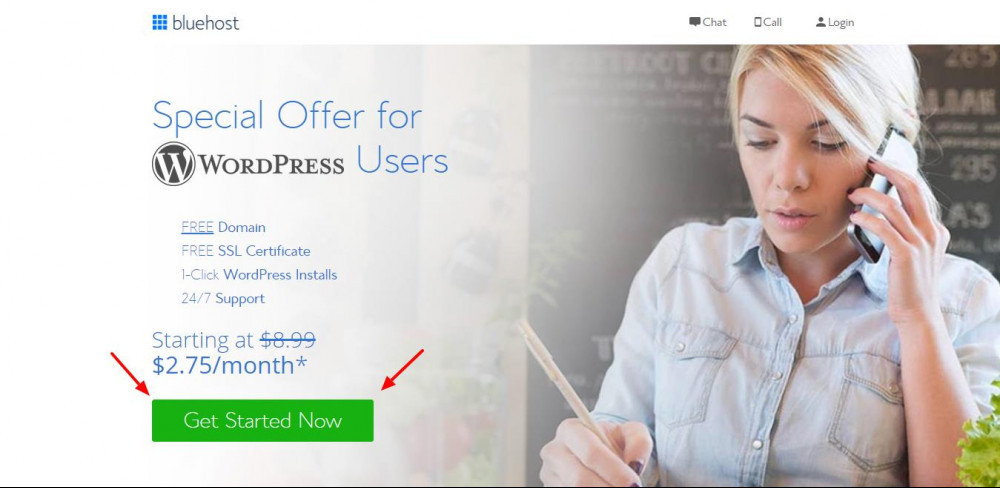
Then you select a plan for your hosting account. Basic and Plus are more popular among users, but you can upgrade whenever you want to access more resources.
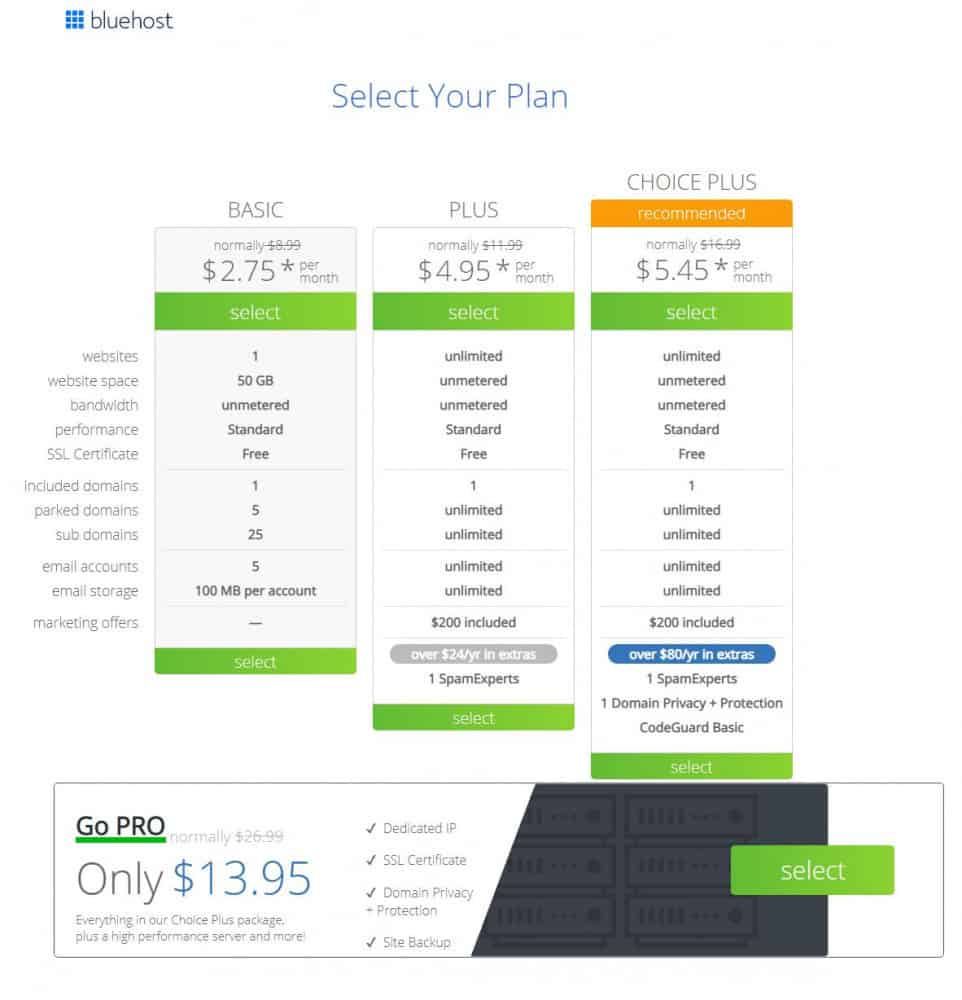
Click the select button on the plan you choose and proceed.
Then, you need to type a domain name or insert an existing domain name that you already have.
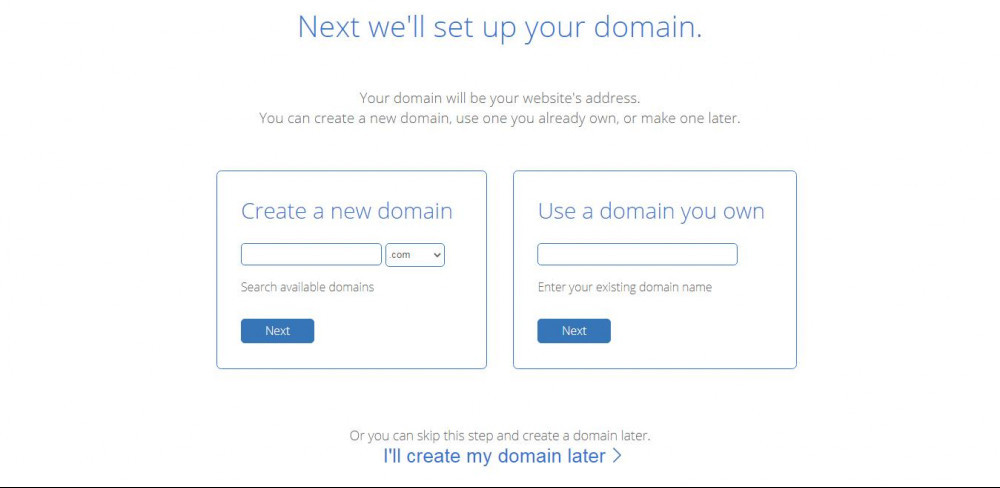
Short tips on choosing the perfect domain name for your WooCommerce store:
- Use keywords. For instance, if you want to sell office supplies, then use it in your domain name as a keyword.
- Use your brand name in it.
- Use the .com extension whenever possible.
- Choose a short domain name so people can easily remember it.
- Do not use hyphens or numbers in your domain name. These cause difficulties when you have to pronounce or spell your domain name.
It is worth spending time thinking about choosing the perfect name for your website. After you decide on your domain name, enter it and hit the next button.
After that, you insert your account information and finalize the details.
We suggest you select the 36 months plan in the “package information” section since it is the best value.
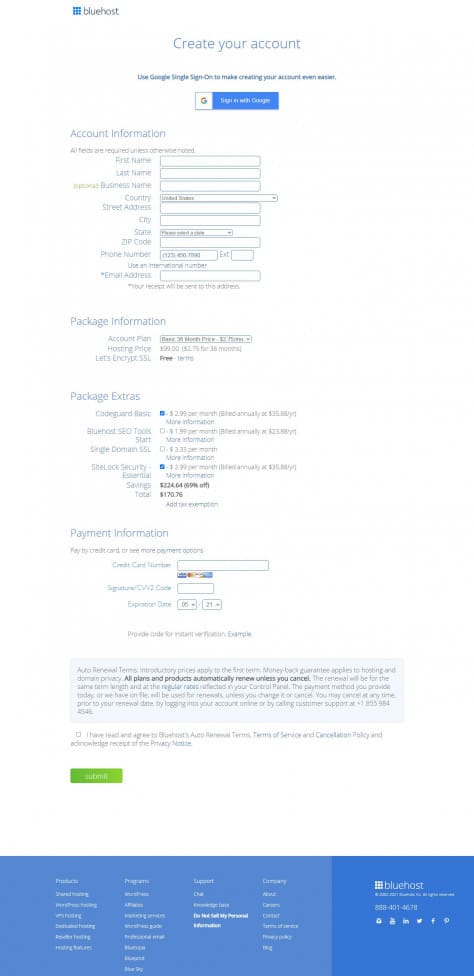
In the “package extras,” leave the boxes unchecked because they will increase your cost. If you need them later, you can add them to your hosting dashboard at any time.
Finally, fill in your credit card information and press the submit button to finish the buying process.
After you have paid the cost, you will receive an email from Bluehost that includes essential details to log in to your web hosting dashboard. From now on, you can manage your website from your dashboard.
Step 2 – Setting up WordPress And WooCommerce
Most hosting companies offer one-click WordPress installation. When you sign up for a Bluehost hosting account, it will automatically install WordPress for you. Just log in to your hosting dashboard and hit the “Log in to WordPress” button.
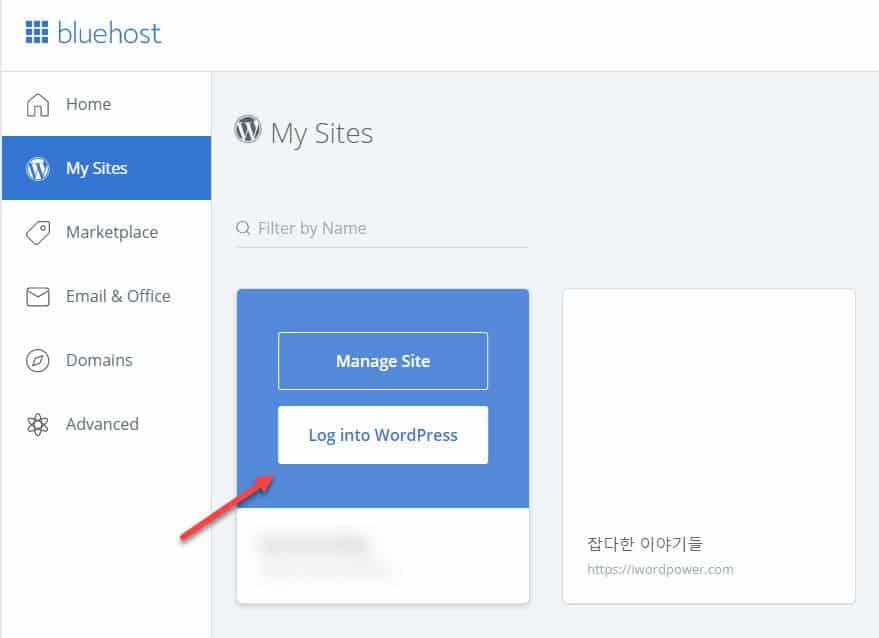
You can create a shortcut to login into your WooCommerce without entering a password. Then you will see the WordPress dashboard.
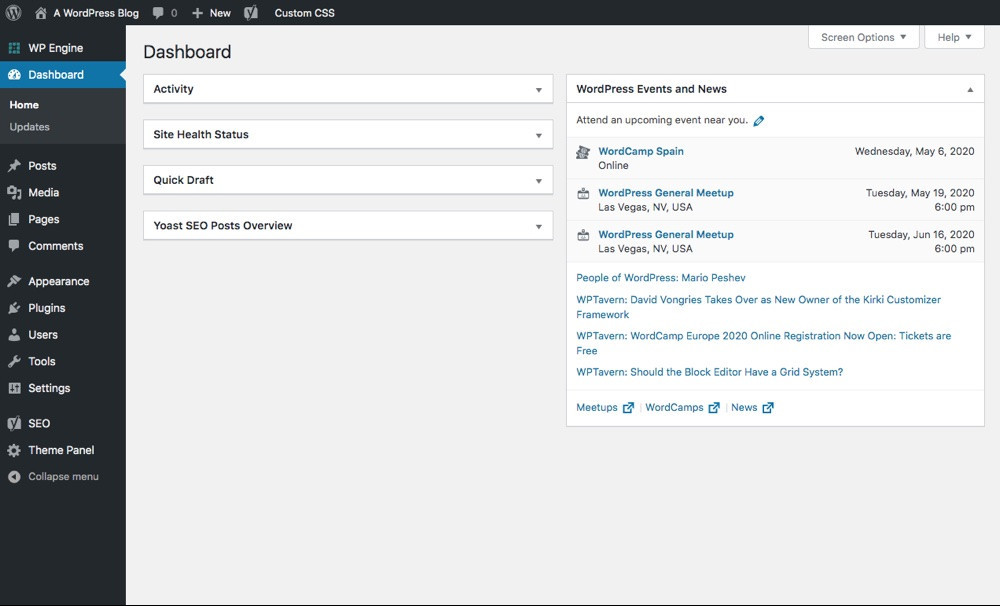
First, let’s set up the basic WordPress settings before installing WooCommerce. Open the General Setting page in the WordPress admin area. And from there, change the website title and insert a tagline, which is optional.
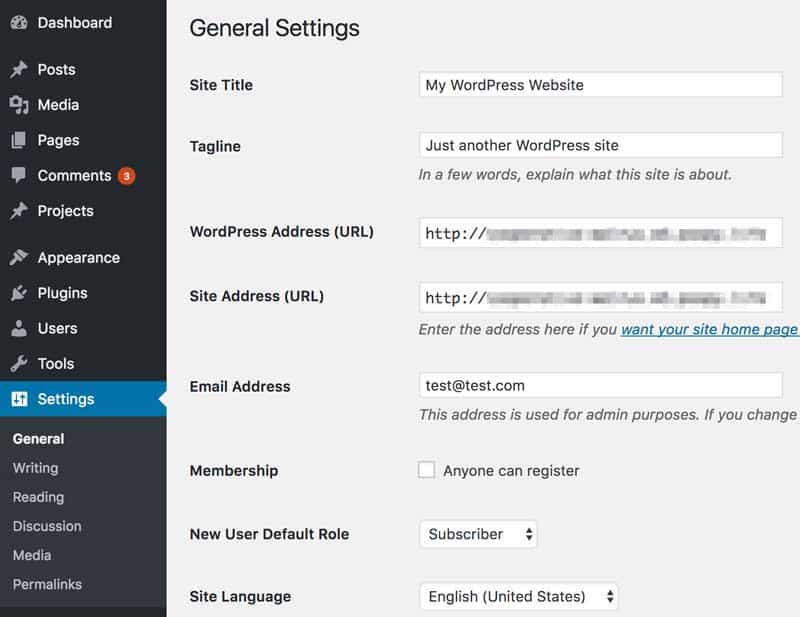
Bluehost will automatically install an SSL certificate for your domain name. Your website URL must be showing HTTPS instead of HTTP. After that, check the website admin email address. WooCommerce will use this email address for their communications and handle password reset requests. That's why you have to make sure it is correct.
To select the timezone setting, scroll down. Please review all the settings one more time, and to save them hit the save changes button. Now you are ready to install WooCommerce.
Step 3 – How To Properly Install And Set Up WooCommerce
WooCommerce is a WordPress plugin, and the installation procedure is just like another plugin from WordPress. Go to Add Plugin in your WordPress admin Dashboard and search for WooCommerce. choose WooCommerce and select “install now.”
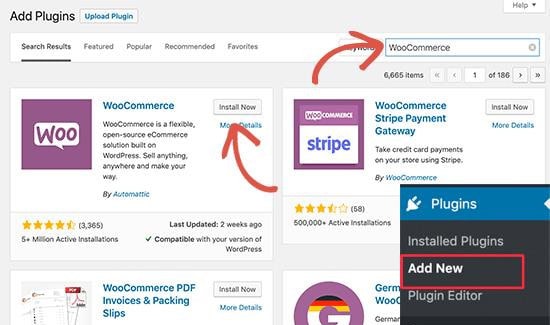
WordPress will then install WooCommerce and when completed, select the “activate” button to start using it.
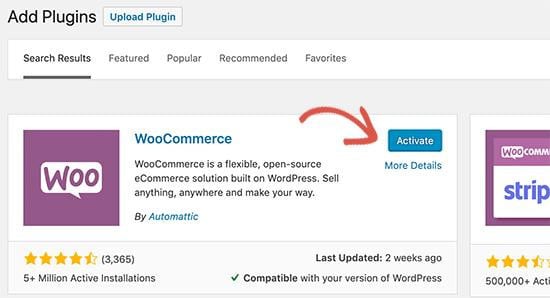
WooCommerce launches the WooCommerce setup wizard. Here you select your store address, currency, and what products you sell.
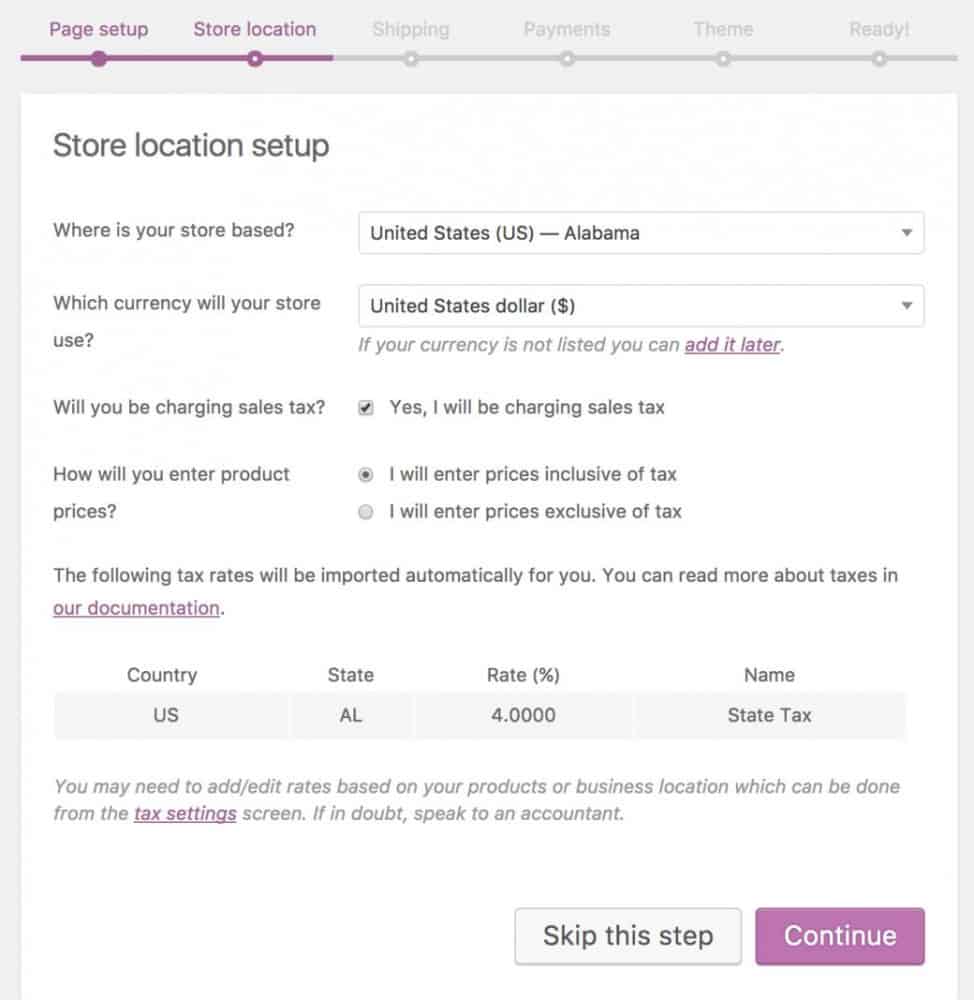
Once you fill out the form, select the continue button. The next step is about your payment method. Stripe and PayPal payment gateways are supported by default.
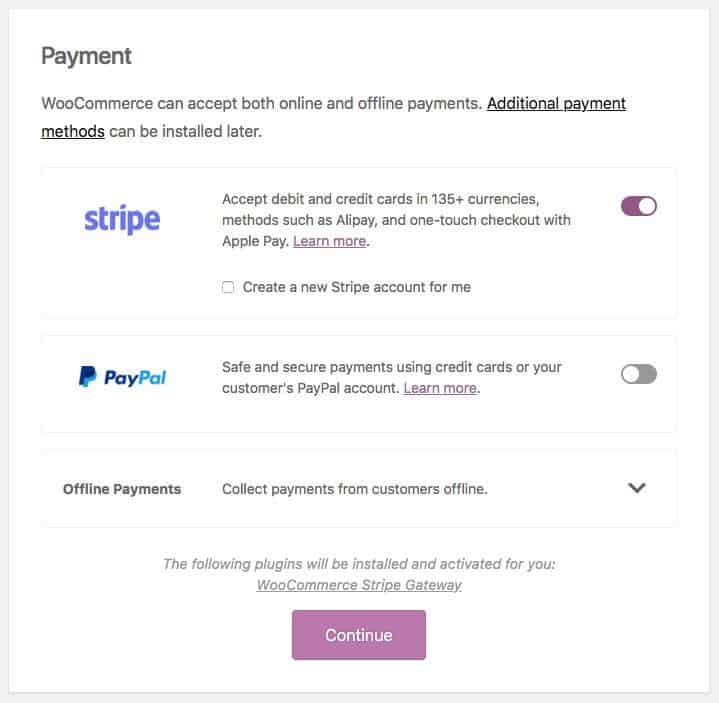
You can either enable these payment methods or turn them off. You can always change them later on by visiting the WooCommerce settings page. Select the payment tab and change your settings.
The next step in the WooCommerce setup wizard is shipping. Select free shipping or add flat shipping costs for the different zones. Select the continue button to proceed.
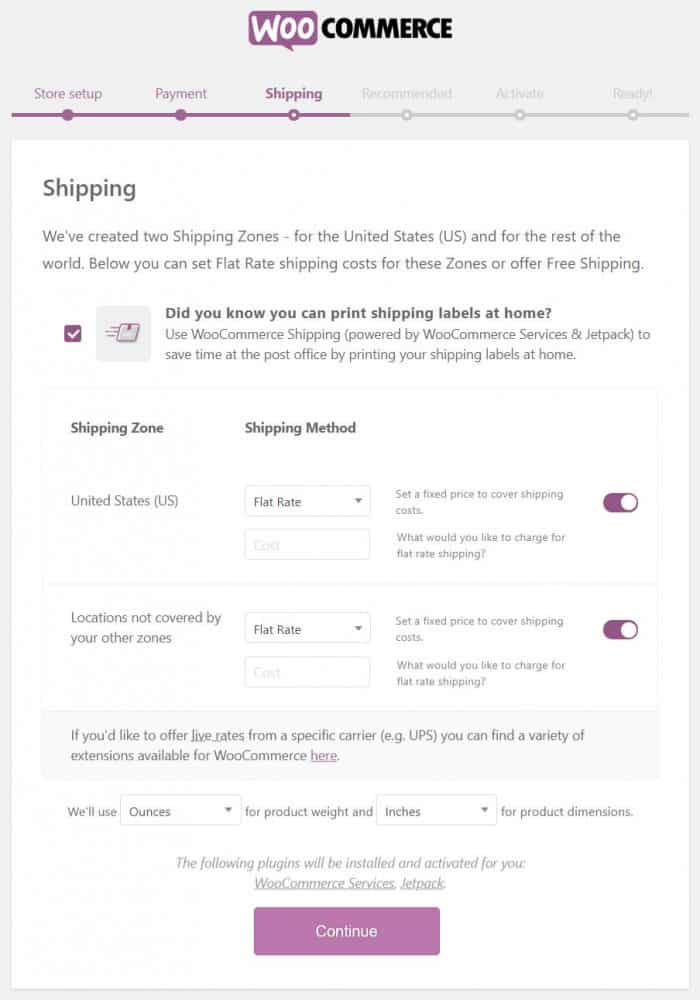
Recommended services for WooCommerce is the next step. You can leave all of them unchecked and install them when you actually need them.
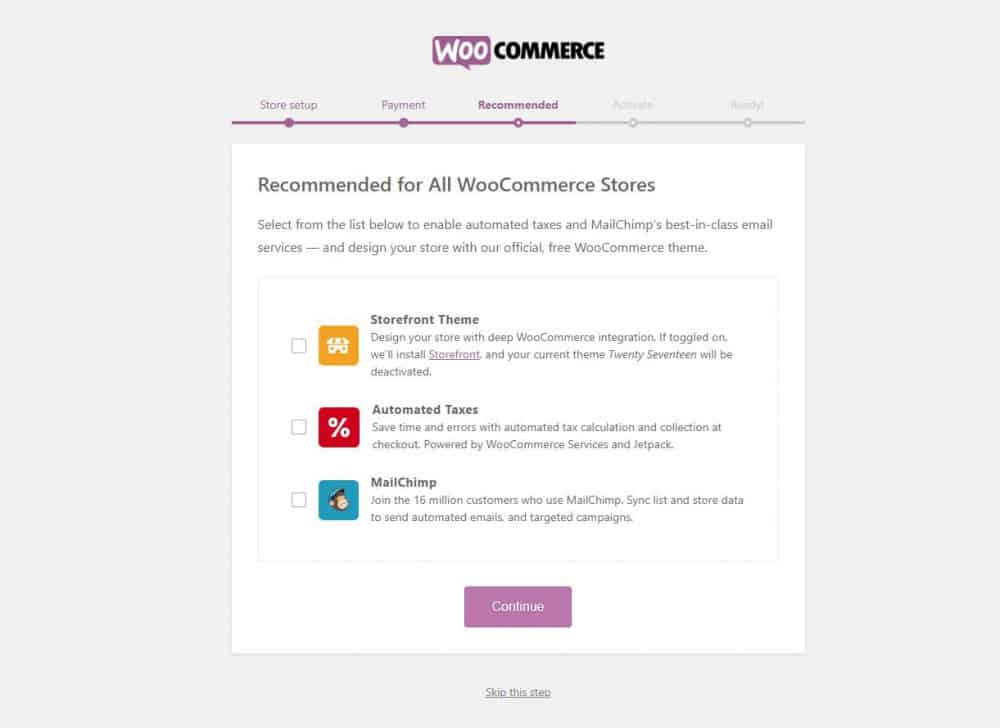
After that, the plugin asks you to install the JetPack plugin. You can skip this step because there are powerful replacements you can use instead.
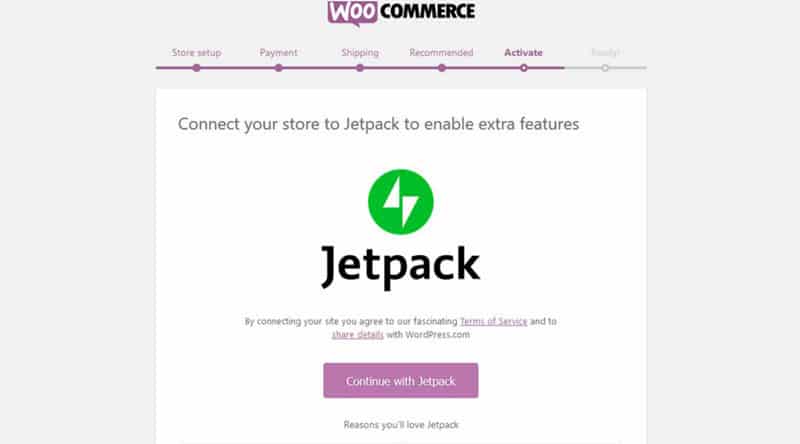
Now all your settings will be saved in the WooCommerce setup wizard. Your store is ready!
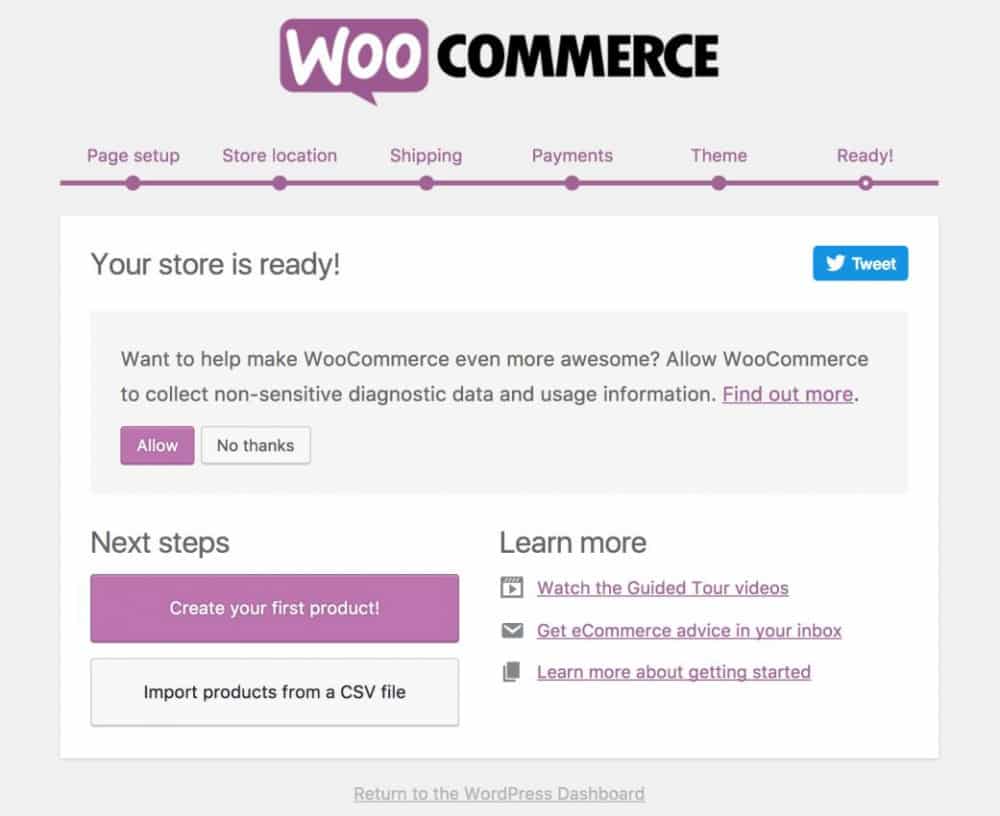
Step 4 – Adding Products
It is straightforward to add products to your store in WooCommerce. To add your product open the product page and then go to Add New tab.
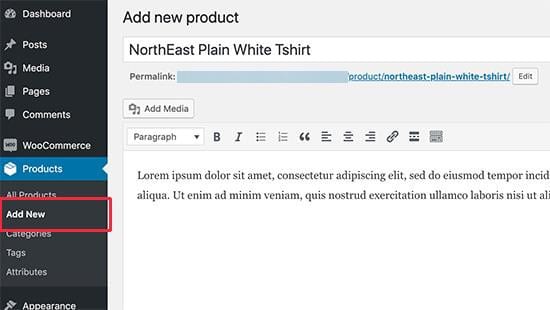
First, write down a title for the product, and then write a description. Later on, hit the “+Add new category” link in the right column. Build a new category for adding products.

Creating categories makes it easy for your customers to browse products on your website. To add the product type, pricing, shipping, and other information, scroll down to the “Product Data” box.
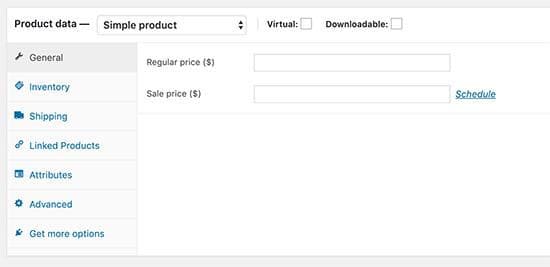
Then, there is a product short description box. It will be used on various product pages on your website. The attractive and informative description will help you receive more clicks.
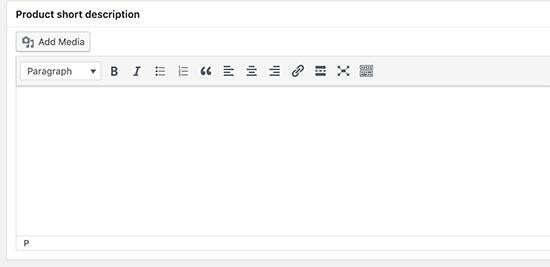
Images of products are beneficial. It is straightforward to add product images and even galleries in WooCommerce. But first, you will have to add the main product image on the shop pages in your online store.

You can add several images to make a product image gallery. Double-check all the product information, and if it looks alright, select the Publish button.
To add more products, repeat the process.
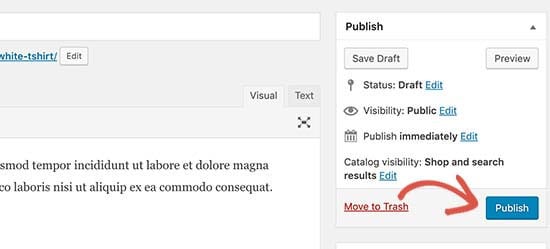
Step 5 – Choosing A Template And Theme
Pick a professional design for the store that improves it in the customers’ views. There are numerous templates and themes on the market. Although you can use any WordPress theme you want, we suggest you pick a WooCommerce-ready theme. These themes are designed for the WooCommerce website and enhance the sales on your website.
There are tons of free and paid WooCommerce themes out there that make it difficult for you to decide. We picked the best WooCommerce ready themes to make it easier for you to select one. All of these themes are responsive and highly optimized. They are:
- Astra
- Outfitter Pro
- Ocean WP
- Shop

What To Look For In A WooCommerce Theme?
Are you wondering how to choose the right theme for your shop?
We provide you with some basic tips to use as a guideline.
- Look for minimal design. Simplicity helps customers concentrate on what is important so that it will improve their income.
- Only get the themes from WordPress.org or reliable theme shops.
- Try the selected theme on mobile. Most customers use their mobile devices to browse the internet. This way, you can check if the theme looks great on a smaller screen or not.
- See the reviews and stay away from any red flags.
Step 6 – Installing WooCommerce Extensions And Add-Ons
Extensions and add-ons make your online shop powerful. You can install add-ons exactly like the WordPress plugin. Numerous plugins are available both for WooCommerce and WordPress. You can utilize them to make contact forms, adding pricing tables, make landing pages, gift cards, etc.
We provide a list of top picks must-have WooCommerce plugins for any store:
- WPForms assists you with creating contact forms, customer login forms, customer surveys, and more.
- MonsterInsights is an excellent add-on that you can use to install Google Analytics and track your top products, categories, and landing pages. You can also check where your customers are from.
- TrustPulse: In this one, you can use the power of social proof to obtain customer trust and improve your sales immediately.
- BeaverBuilder is one of the best page builder plugins. It enables you to build beautiful landing pages that make it easy to advertise products, marketing campaigns, and more.
- RafflePress assists you in launching viral giveaway campaigns to improve your WooCommerce store.
- PushEngage enables you to contact your visitors by web push notifications after they leave your website.
Step 7 – Resources To Grow Your WooCommerce Store
When your store is launched and running, start advertising your store and herewith develop your business. There are some ways to do that:
1. Start An Email List
Over 90% of people who visit your WooCommerce store will not buy anything and leave. Try not to lose these users. Building an email list is crucial for online store owners.
An email list makes it possible for customers to connect with you without making a purchase. This is an excellent way of communicating between you and your potential customers so you can convince them to shop later.
2. Generate More Leads
Every single user who subscribes to your email list is considered a potential customer or lead. Offer multiple options to the visitors and encourage them to join your email list. This is called lead generation. OptinMonster is the best software for lead generation and enables you to convert abandoning visitors into email subscribers.
3. Track WooCommerce Users
To make informed decisions in an eCommerce store, you need marketing data. This information is composed of which products are popular, where your visitors are coming from, which products are not doing well, and so on. It helps you make informed decisions and modify your marketing strategy based on that.
MonsterInsights using Goggle Analytics assists you in making sense of all this data.
4. Learn How To Use SEO
Search Engine Optimization (SEO) aids you in obtaining more visitors from search engines to your store. Although WooCommerce itself is very SEO-friendly, there are many more things you can do.
5. Recover Abandoned Cart Sales
Many customers add some products to their carts. However, 60 to 80% of them will leave without completing their purchase. This number can be even higher!
Most stores do not attend to this metric and are leaving the potential income on the table. There is a cheat sheet to recover WooCommerce abandoned cart sales. This will improve your overall sales.
Conclusion
WooCommerce is the most popular eCommerce software around the world. It is simple for beginners and has convenient features. WooCommerce is open-source software, so it is totally free. The only investment you will have to make is for your domain name and the hosting services. You can use WooCommerce to build as many online stores and websites as you want. WooCommerce is based on WordPress, so you can benefit from all of WordPress’s great features as well.
I trust you enjoyed this easy-to-follow WooCommerce tutorial. Please stay tuned for more information to come. Take care!
JeannetteZ
Your Opinion Is Important To Me
I would love to hear from you. Please leave me your questions, experiences, remarks, and/or suggestions about this tutorial in the comments section below. You can also reach me by email at Jeannette@WorkFromAnywhereInTheWorld.com.

